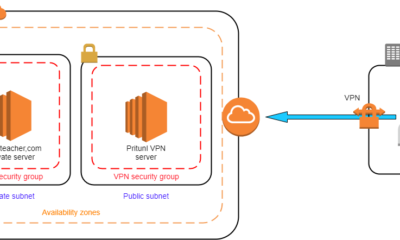DevOps
How the Linux Scheduler (Cfs) Works Internally: Unveiled
Curious about how your computer efficiently manages tasks, juggling multiple applications without missing a beat? The secret lies in the Linux scheduler, particularly the Completely Fair Scheduler (CFS).
Whether you’re a tech enthusiast, a developer, or someone who simply loves understanding how things work, delving into the workings of the CFS can be fascinating. Imagine your computer as a well-oiled machine, with each part working harmoniously. The CFS is like a skilled conductor, ensuring each task gets its fair share of processing time.
By understanding its inner workings, you gain insights into how your computer remains responsive, even under heavy load. Ready to demystify the complexities and uncover the magic of the Linux scheduler? Let’s dive in and unravel how the CFS keeps your system running smoothly.
Linux Scheduler Basics
Understanding the Linux Scheduler is vital for grasping OS performance. The scheduler decides which process runs at any given time. It ensures efficient CPU utilization. This section will explore the basics of the Linux Scheduler, focusing on its role and evolution.
Role Of The Scheduler
The scheduler is the brain of the CPU. It manages process execution. It prioritizes tasks based on specific criteria. This ensures high performance and responsiveness. The scheduler optimizes CPU time allocation among processes. Each process gets a fair chance to run. This prevents any single task from hogging resources.
Brief History Of Cfs
The Completely Fair Scheduler (CFS) was introduced in 2007. It replaced the O(1) scheduler in Linux 2.6.23. CFS was designed to be fair and efficient. It uses a red-black tree data structure. This allows for quick scheduling decisions. CFS focuses on fair CPU time distribution. It aims to be simple yet effective.

Credit: deepdives.medium.com
Core Components Of Cfs
The Completely Fair Scheduler (CFS) is a key part of the Linux kernel. It efficiently manages CPU resources. Understanding its core components helps grasp its functioning. CFS aims for equal CPU time distribution among tasks. It ensures fairness and performance in multi-tasking environments.
Runnable Tasks
CFS organizes tasks in a red-black tree structure. This ensures quick access and sorting. Each task has a unique position based on its virtual runtime. Runnable tasks are those ready to execute immediately. They wait in the tree for CPU allocation. Efficient task management reduces delays and boosts system performance.
Virtual Runtime Calculation
CFS uses virtual runtime to prioritize tasks. It calculates virtual runtime based on actual time spent on CPU. Tasks with lower virtual runtime get higher priority. This approach ensures fairness across all tasks. Virtual runtime calculation is crucial for balanced CPU time distribution. It prevents any task from monopolizing CPU resources.
Balancing Fairness And Efficiency
The Linux Scheduler, known as Completely Fair Scheduler (CFS), manages tasks to ensure fairness. It balances efficiency by allocating CPU time based on task priority. This approach enhances system performance while maintaining equitable resource distribution.
Balancing fairness and efficiency in a Linux system might remind you of trying to keep a seesaw level. You want all tasks to get their fair share of CPU time while ensuring the system runs smoothly. Achieving this balance is the core mission of the Completely Fair Scheduler (CFS) in Linux.Load Balancing Techniques
Load balancing in Linux involves distributing tasks evenly across CPUs. This ensures that no single CPU is overwhelmed while others sit idle. Imagine being in a group project where one person does all the work while others watch. That’s what CFS tries to avoid by spreading tasks out. CFS uses techniques like task migration to shift tasks from busy CPUs to less busy ones. This keeps things running smoothly and prevents bottlenecks. Have you ever noticed your computer slowing down when running multiple programs? Efficient load balancing aims to prevent that.Task Prioritization
Prioritizing tasks is crucial in maintaining a fair and efficient system. CFS assigns different importance levels to tasks based on their needs. This ensures that critical tasks get enough CPU time while others wait their turn. Consider how you prioritize your daily tasks, giving more time to what matters most. Similarly, CFS ensures high-priority tasks get the attention they deserve. But how does it decide which task is more important? Factors like task type and time spent waiting play a role. By understanding these techniques, you can appreciate how CFS balances fairness and efficiency. Next time your system runs smoothly, thank the scheduler working tirelessly behind the scenes.Tree Data Structures
The world of Linux scheduling is a fascinating realm where precision meets performance. At the heart of this system are tree data structures, crucial for managing tasks efficiently. Understanding these structures isn’t just for tech enthusiasts; it’s for anyone curious about how their computer decides which task gets attention next. Imagine a tree where each branch represents a task. This is what the Linux scheduler relies on to ensure your applications run smoothly.
Red-black Tree Usage
The Linux Scheduler uses a special kind of tree known as the Red-Black Tree. This isn’t just any tree; it’s balanced and ensures tasks are handled efficiently. Have you ever wondered why your system doesn’t hang when running multiple apps? The Red-Black Tree is the unsung hero. It maintains balance by coloring nodes red or black, ensuring no path from root to leaf is excessively long. This balance is vital for quick task retrieval.
Picture yourself organizing files with a system so precise that no folder is ever too far from your reach. That’s the Red-Black Tree’s promise for tasks. It’s a system that prioritizes efficiency, allowing the Linux Scheduler to manage processes swiftly and fairly. But how does this affect you directly? Faster responses, smoother multitasking, and a more reliable computing experience.
Inserting And Deleting Tasks
Every time you open a new app or close one, tasks are added or removed from the scheduler’s tree. This is where insertion and deletion come into play. Have you ever closed a lagging app and noticed immediate performance improvement? That’s the scheduler at work, efficiently managing the task tree.
Adding tasks to the tree is like adding new branches. The scheduler places them in the right spot to maintain balance. Deleting is equally crucial; it’s pruning the tree, ensuring no dead branches slow down performance. This dynamic adjustment keeps your system responsive. Consider how you arrange your workspace—removing clutter boosts productivity. The scheduler does the same for your computer.
Next time your system runs smoothly even with heavy multitasking, remember the tree data structures working tirelessly behind the scenes. They ensure each task is handled swiftly and fairly. Do you think your computer could manage without such a precise system? Reflect on the times you’ve switched between apps seamlessly—it’s all thanks to these intricate tree data structures.
Handling Interrupts
Understanding how the Linux Scheduler handles interrupts is crucial. Interrupts ensure smooth multitasking in a system. The scheduler manages these with precision. By doing so, it maintains system performance and efficiency. This section delves into two key aspects of handling interrupts.
Scheduler Tick
The scheduler tick is a time-based signal. It triggers periodic checks on running tasks. Each tick is like a heartbeat for the scheduler. It ensures the system is responsive. The tick decides if a task continues or yields. This decision impacts system responsiveness.
Ticks occur at regular intervals. They keep the scheduler informed about task progress. Without ticks, tasks might hog resources. The scheduler tick maintains balance in task execution.
Preemption Points
Preemption points allow the scheduler to interrupt a task. This happens when a higher-priority task needs execution. Preemption ensures critical tasks run promptly. It enhances the system’s real-time performance.
Preemption points are strategically placed. They allow safe interruption without data loss. This careful placement avoids system instability. The scheduler uses these points to manage task priority effectively.
Performance Metrics
The Linux Scheduler, specifically the Completely Fair Scheduler (CFS), manages system processes. It ensures fair CPU time distribution across tasks. CFS uses a red-black tree structure for tracking process time, ensuring efficient scheduling.
Understanding the performance metrics of the Linux Scheduler, particularly the Completely Fair Scheduler (CFS), is crucial for optimizing system efficiency. These metrics are the backbone that supports the scheduler in deciding which process runs next and how long it should run. Grasping these metrics not only helps in improving system performance but also in troubleshooting when things don’t go as planned.Latency And Throughput
Latency refers to the time it takes for a process to begin executing once it has been scheduled. It’s the delay from when a process requests CPU time to when it actually receives it. High latency can lead to sluggish performance, affecting user experience. Throughput, on the other hand, measures the amount of work done in a given timeframe. It’s about how many processes are completed. High throughput is desirable for a system to handle multiple tasks efficiently. Balancing latency and throughput is a delicate act. Imagine you’re juggling tasks at work; if you focus solely on starting tasks quickly (low latency), you might end up with unfinished tasks piling up, reducing overall throughput.Real-world Benchmarking
Benchmarking is like taking your car for a test drive to see how it performs in real-world conditions. It’s essential for understanding how the Linux Scheduler performs under various workloads. You might wonder why benchmarking is necessary. Simple: it uncovers the strengths and weaknesses of the scheduler in different scenarios. By running specific tests, you can see how your system handles tasks that require high throughput or low latency. Have you ever tried benchmarking your own system to see how well it handles everyday tasks? It’s a fun experiment and can offer insights into performance bottlenecks. Real-world benchmarking involves running simulations that mimic typical workloads, helping you fine-tune your system for optimal performance. Is your system sluggish when running multiple applications? Consider tweaking your scheduler settings based on benchmarking results. Such adjustments can lead to smoother operations and better user satisfaction. Understanding these metrics can empower you to make informed decisions about system optimization. Are you ready to dive into the world of performance metrics and make your Linux system more efficient?Challenges And Limitations
The Linux Completely Fair Scheduler (CFS) is crucial for task management. It ensures efficient CPU time distribution among processes. Despite its strengths, CFS faces challenges and limitations. Understanding these helps in optimizing Linux systems.
Scalability Issues
Scalability is a major concern for CFS. As systems grow, maintaining performance becomes tough. CFS uses a red-black tree to manage processes. This tree structure struggles with a large number of tasks. The time complexity increases with more processes. This can slow down scheduling decisions. Ensuring fair CPU distribution becomes harder.
Complexity Of Scheduling
The scheduling process in CFS is complex. Balancing CPU time among processes requires intricate calculations. CFS aims for fairness, but this adds to the complexity. The scheduler must handle various process priorities. Real-time tasks add another layer of difficulty. These complexities can cause inefficiencies. Understanding these helps in improving scheduler performance.

Credit: svalaks.medium.com
Future Developments
The Linux Scheduler, known as the Completely Fair Scheduler (CFS), is crucial. It manages how the operating system allocates CPU resources. Understanding its future developments is important for developers and tech enthusiasts. These developments promise enhanced efficiency and performance.
Upcoming Kernel Changes
Linux kernel updates often include scheduler improvements. Developers aim to boost performance and resource management. Upcoming changes might focus on better load balancing. This ensures tasks are distributed evenly across CPUs. Improved efficiency could lead to faster processes.
Another focus could be power management. Reducing power consumption is vital for mobile and embedded devices. Kernel changes may introduce smarter power usage strategies. This would benefit devices with limited power sources.
Potential Improvements
Developers are exploring ways to optimize task scheduling. One potential improvement involves enhancing task priority handling. This ensures critical tasks receive the necessary CPU time. Such changes could improve overall system responsiveness.
Improving real-time performance is another focus area. Real-time tasks require consistent response times. Enhancements in this area could support real-time applications better. This would be beneficial for industries relying on time-sensitive operations.
Scalability is another key area. As systems grow, efficient resource allocation becomes vital. Improvements in scalability could lead to better performance in large systems. This is important as technology continues to advance.

Credit: developer.ibm.com
Frequently Asked Questions
What Is The Linux Cfs Scheduler?
The Completely Fair Scheduler (CFS) in Linux manages process execution. It aims to allocate CPU time fairly across all tasks. CFS calculates the time each process should run based on its priority. It uses a red-black tree structure to efficiently manage processes, ensuring fairness and responsiveness.
How Does Cfs Improve System Performance?
CFS enhances performance by ensuring fair CPU time distribution. It minimizes latency and maximizes responsiveness for tasks. By using a red-black tree, it efficiently manages process priorities. This approach reduces overhead and ensures smoother multitasking, optimizing overall system performance and user experience.
Why Is Cfs Preferred Over Other Schedulers?
CFS is preferred for its fairness and efficiency. It provides equal CPU access to all processes. Its balanced approach minimizes priority inversion and starvation issues. CFS’s design ensures smoother multitasking and better responsiveness compared to traditional schedulers, making it ideal for modern Linux systems.
How Does Cfs Handle Process Priorities?
CFS uses a virtual runtime to manage priorities. Each process gets a fair share of CPU time based on its priority. Lower priority processes receive less time, while higher priority ones get more. This ensures balanced resource allocation, preventing any single process from monopolizing CPU resources.
Conclusion
Understanding the Linux Scheduler (Cfs) reveals its efficient design. It balances tasks, ensuring smooth operation. It relies on fair scheduling principles. This keeps processes running without delay. With Cfs, tasks get equal chance to execute. This ensures optimal system performance.
Developers appreciate its simplicity and effectiveness. Cfs adapts to different workloads seamlessly. This makes it popular in diverse environments. Users benefit from consistent system responsiveness. Exploring its workings enhances appreciation of Linux’s capabilities. It’s vital for those interested in system performance.
Dive deeper into its mechanisms for more insights. Linux continues evolving, driven by these powerful tools.
-

 DevOps6 years ago
DevOps6 years agoSaltstack Tutorial for beginners [2025]
-

 DevOps6 years ago
DevOps6 years agoHow to build a Docker cron job Container easily [2025]
-

 Linux6 years ago
Linux6 years agomail Command in Linux/Unix with 10+ Examples [2025]
-

 DevOps6 years ago
DevOps6 years agoDocker ADD vs COPY vs VOLUME – [2025]
-

 DevOps6 years ago
DevOps6 years agoHow to setup Pritunl VPN on AWS to Access Servers
-

 Linux6 years ago
Linux6 years agoGrep Command In Unix/Linux with 25+ Examples [2025]
-

 Linux6 years ago
Linux6 years agoFind command in Unix/Linux with 30+ Examples [2025]
-
Linux5 years ago
How To setup Django with Postgres, Nginx, and Gunicorn on Ubuntu 20.04

